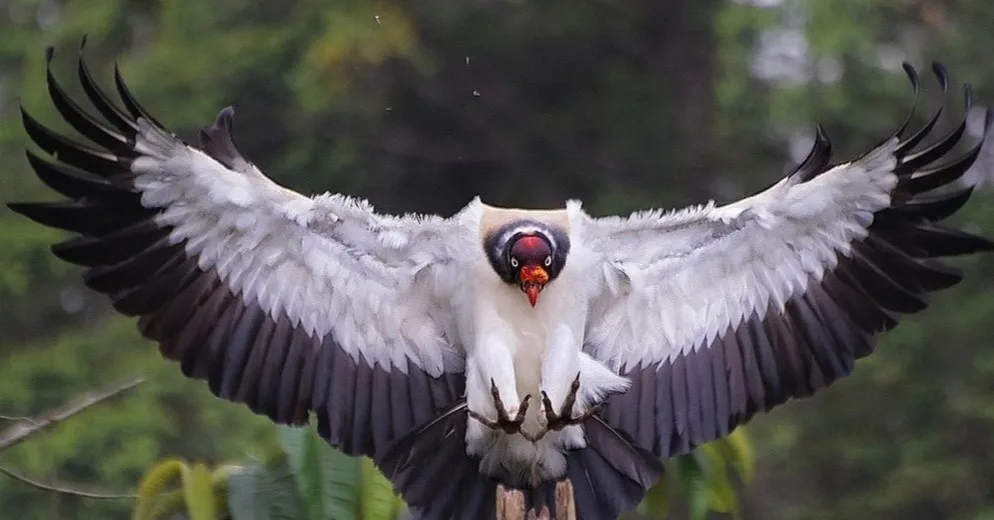The King Vulture (Sarcoramphus papa) is a majestic scavenger bird of the tropical forests of the Americas. With mostly white plumage, black wings, and a colorful head (orange, yellow, and purple), it stands out among American vultures. The word papa in its scientific name means “bishop” in Latin, referring to its bright plumage reminiscent of a bishop’s robe. This species is the only living member of the genus Sarcoramphus and can live up to 30 years in both captivity and the wild. Tourists interested in exotic wildlife seek tours in the Peruvian Amazon to spot it, and reliable agencies offer trips to reserves like Manu or Bahuaja Sonene, where it can be seen in its natural habitat.
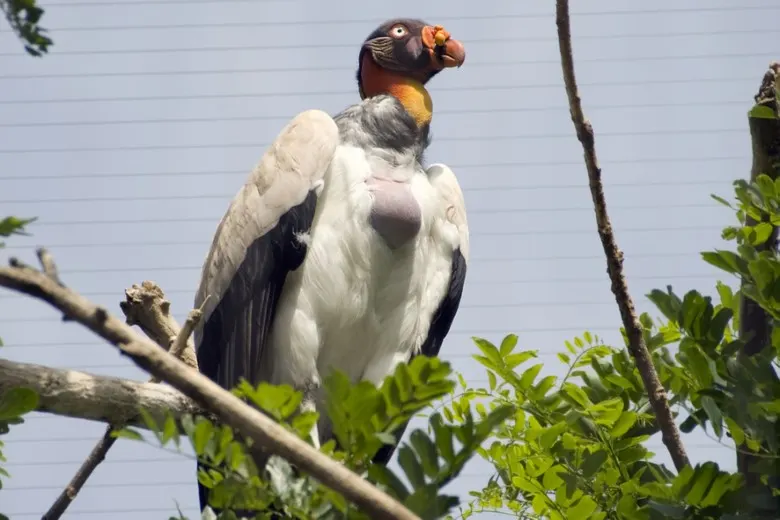
What is the King Vulture (Sarcoramphus papa)?
The King Vulture, also known as jungle condor, chom, royal crow, royal buzzard, king zope, or king zamuro, is a species of bird from the American vulture family (Cathartidae). It is known for its large size (between 71 and 81.5 cm in length and weighing around 2.7–4.5 kg) and a spectacular bicolor plumage: white body, black wings, and a dark neck with an orange eye ring. Unlike other American vultures, it lacks eyelashes and has long gray legs with strong talons. This scavenger makes the first cut on large carcasses and drives away smaller vultures nearby. The name papa comes from the Latin for “bishop,” referencing its black-and-white plumage that resembles clerical garments.
- It has natural predators as a chick: snakes and large felines (such as jaguars) have been seen attacking nests to eat eggs or chicks. A jaguar could also kill an adult on the ground, though that is rare.
- Regional names are very creative: “king buzzard” emphasizes its dominance over other vultures; “royal crow” compares its curved beak to that of crows; “king chombo” is another local variant; and “king of the buzzards” highlights its status as the monarch among vultures.
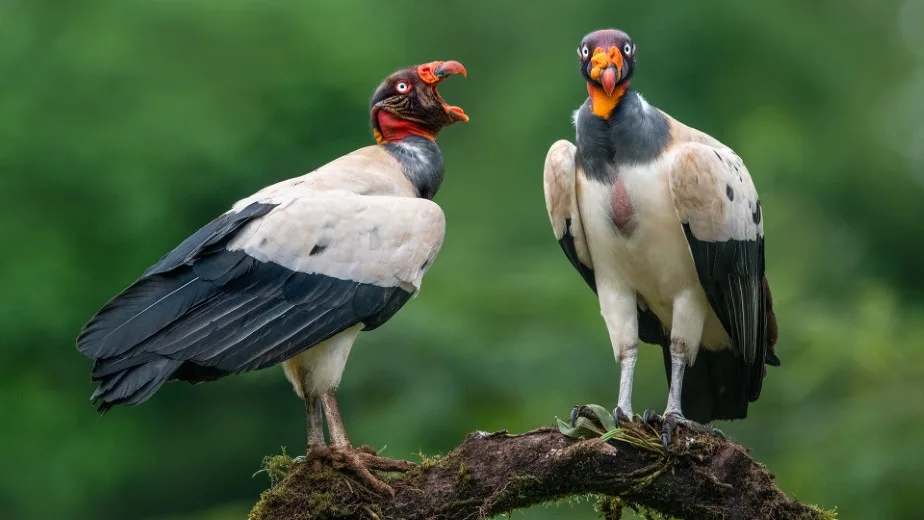
Where does the King Vulture live in the world?
The King Vulture lives in the humid tropical forests of Latin America. Its range extends from southern Mexico to northern Argentina. It prefers lowland rainforests (plains and valleys) up to around 1,000–1,500 meters in elevation. It is uncommon in open areas, except near forest edges. In Peru, it is found throughout the Amazon region (Loreto, San Martín, Ucayali, Madre de Dios, Amazonas, and Cajamarca) and also in the dry northern forests (Lambayeque, Piura, Tumbes). At South America, it lives in Brazil (Amazon), Bolivia, Colombia (Amazon region), Venezuela, Ecuador, Peru, northeastern Paraguay, southern Mexico, and Central America (Guatemala, Belize, Honduras, Nicaragua, Costa Rica, Panama). In these areas, it perches in tall treetops or soars over rivers and forest clearings, always near moist forests.
Behavior and Diet of the King Vulture
The King Vulture is a quiet and mostly solitary scavenger. It soars for hours with its wings held flat, sometimes appearing almost “headless” due to its posture. It mainly feeds on carrion (dead animals), ranging from large mammals to stranded fish and dead lizards. Usually finds food by watching other vultures or using its keen eyesight; some studies suggest it may detect scent in the jungle and follow vultures with better olfactory senses to a carcass.
When it arrives at a carcass, it drives off smaller vultures due to its size and powerful beak; it usually only yields to the Andean condor (which is larger). Although it rarely builds high nests, it rests and nests in large trees. To cool down, it sometimes defecates on its legs, a behavior called urohidrosis—evaporation cools the body. Juveniles (grayish in color) look very different from adults and take years to develop full adult plumage.
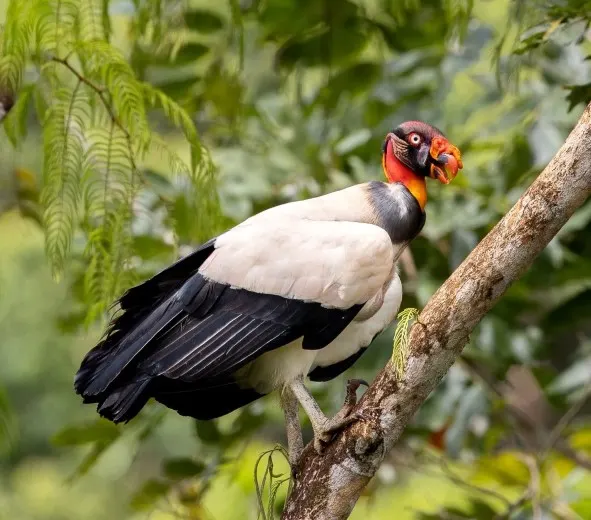
Adaptations and Measurements of the King Vulture
The King Vulture measures about 71–81 cm in length, with a wingspan of nearly 2 meters. It weighs between 2.7 and 4.5 kg, making it one of the largest American vultures. Its plumage is functional: the mostly white body with black wings and tail helps it blend in with forest clearings. Its bare head and neck prevent bacterial buildup while feeding on carrion. The bare skin with black bristles allows the sun to sterilize any bacteria from decomposing meat.
Its legs are long and strong, but it walks awkwardly—it’s better suited for flying. The large talons help it hold large pieces of meat. There are no visible differences between males and females in plumage. Unlike many other vultures, it has no visible eyelashes. In flight, it flaps its wings deeply and can reach great heights soaring over the forest canopy.
Ecological Importance and Conservation Status of the King Vulture
The King Vulture plays a key role in the ecosystem as a scavenger. By feeding on dead animals, it prevents disease and recycles nutrients in the rainforest. This vulture makes the first incision on many large carcasses, helping smaller scavengers access the meat. It helps keep wildlife populations healthy. Currently, the IUCN lists it as “Least Concern” (LC), meaning its global population is not critically endangered for now.
However, it still faces threats: Amazon deforestation is reducing its habitat; pesticides and lead in poisoned carcasses can harm it; and in some places, it suffers from illegal hunting or trade (for feathers or supposed medicinal uses). In Mexico, it is considered endangered by law. That’s why it’s essential to protect its habitat and support conservation projects. In addition, its exotic appearance attracts birdwatching tourism in South America, supporting the local economy through responsible ecotourism in Amazonian communities.
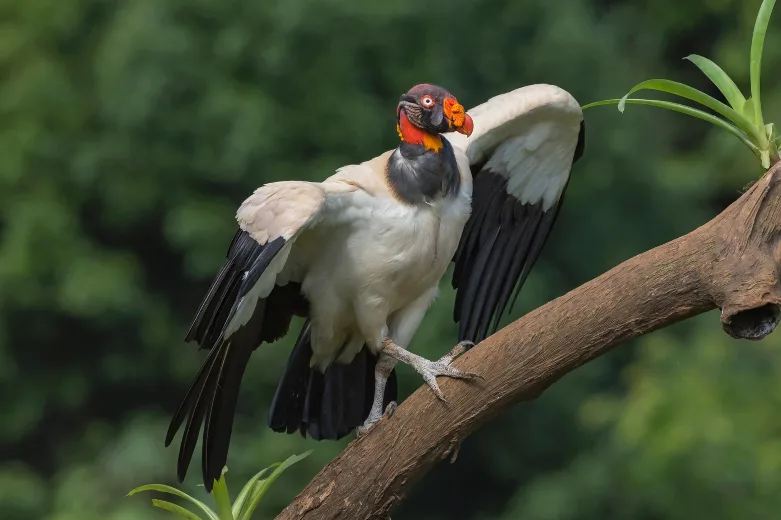
Curiosities and Amazing Facts about the King Vulture (Sarcoramphus papa)
- It is the third largest American vulture, only surpassed by the Andean Condor and the California Condor. It has a strong beak and powerful talons.
- It inhabits a very wide range: from southern Mexico to northern Argentina.
- Its bare head changes color with age and mood: bright orange in healthy individuals, and reddish or purplish tones depending on how it regulates its temperature or gets excited.
- Unlike most birds, it does not have a syrinx (voice organ), so it cannot produce complex calls. It only grunts and whistles during courtship and makes a sharp call by moving its beak when it feels threatened.
- It often flies alone or in pairs; large flocks of King Vultures are very rare. Groups of up to 12 have been reported, but it usually flies solo.
- Juveniles are almost completely gray and only acquire the colorful adult plumage after several years.
- Its scientific name Sarcoramphus comes from the Greek “sarco-” (flesh) and “-ramphus” (beak), referring to its scavenger diet.
- Despite its size, it is an agile flyer. From afar it may look like it’s flying without a head, an optical illusion caused by its posture in the air.
- It is not a migratory bird; it remains in its territory all year round. It responds to food shortages by moving locally in search of carrion but does not undertake long journeys like other birds.
- It can descend below the trees and occasionally eat fallen fruit (it has been seen feeding on palm fruits when carrion is scarce).
- It is monogamous during the breeding season. It lays only one egg in a tree cavity or rotting trunk at a time. Both parents care for the egg.
- It uses a unique cooling technique: urohidrosis, meaning it defecates on its legs so the evaporation cools its body temperature.
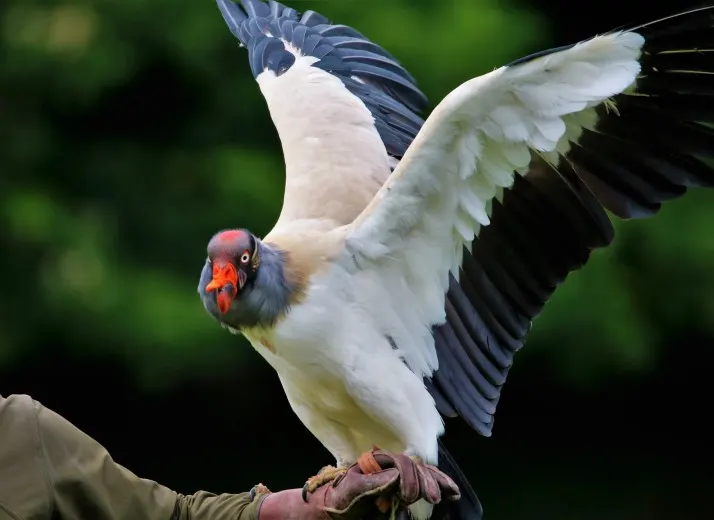
Countries Where the King Vulture Can Be Seen in the Wild
The King Vulture is distributed throughout Latin America. It can be seen in the wild in countries such as:
- Brazil and Bolivia (Amazon regions)
- Peru (eastern Amazon and parts of the dry forest)
- Colombia and Venezuela (Amazon regions and northern plains)
- Guatemala, Honduras, Nicaragua, Costa Rica, and Panama (Central America’s humid forests)
- Ecuador (northern coast and Amazon)
- Argentina (north: Misiones, Corrientes, Chaco, Formosa, part of the littoral; never in the south)
- Mexico (southeast, Chiapas, and low tropical zones)
In these tropical and subtropical regions, the King Vulture rules the forest skies. It can be spotted soaring over lowland rainforests or wooded savannas near forests.
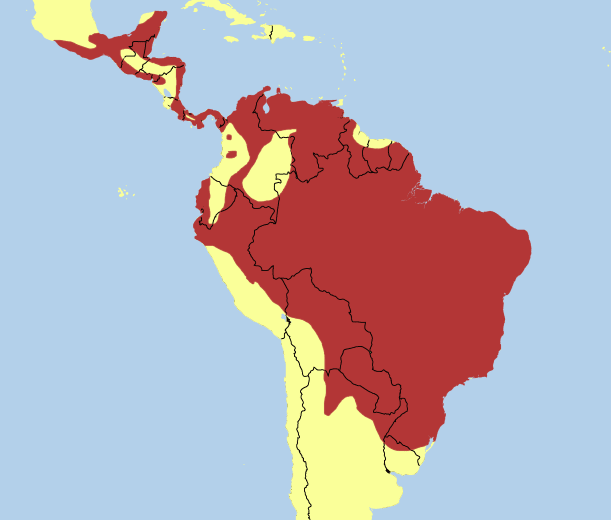
National Parks and Nature Reserves in Peru Where the King Vulture Lives (Sarcoramphus papa)
In Peru, there are several protected areas where the King Vulture can be observed in the wild. The most important include:
- Bahuaja-Sonene National Park (Madre de Dios and Puno): a highly diverse Amazonian area. King Vultures have been recorded in its forest and savanna regions.
- Manu National Park (Cusco and Madre de Dios): the forests of Manu, a World Heritage Site, offer great opportunities for observation.
- Río Abiseo National Park (San Martín and La Libertad): a forested area on the eastern slope. The species is listed among the protected birds.
- Pacaya-Samiria National Reserve (Loreto): Peru’s largest wildlife reserve. Among its rich fauna is the King Vulture.
- Tamshiyacu-Tahuayo Communal Reserve (Loreto): Amazon forest north of Iquitos. Sightings of the species have been reported.
- Allpahuayo-Mishana National Reserve (Loreto): near Iquitos, protects primary forests. There are confirmed records of the species in this reserve.
These areas, with intact primary forest, are ideal for spotting the King Vulture. Many agencies offer eco-tours to these parks. Remember that to enter parks like Manu, it is mandatory to go with a licensed guide.
Frequently Asked Questions about the King Vulture (Sarcoramphus papa)
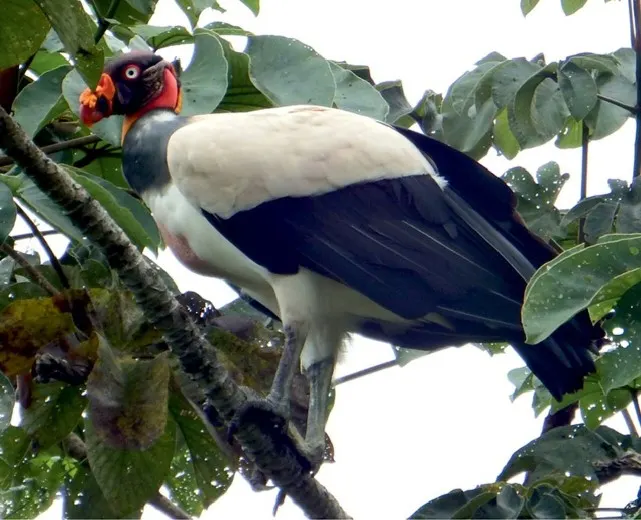
1. Is the King Vulture endangered?
Currently, the IUCN lists it as Least Concern (LC), as it still has wide populations. However, it is locally threatened by forest loss and poisoning. This is why its conservation is essential for maintaining ecological balance.
2. How can you tell the King Vulture apart from other vultures?
At first glance, it stands out for its white plumage and multicolored bare head. Other American vultures are darker (black or brown). The King Vulture has no feathers on its head or eyelashes, and its bicolored beak (yellow and orange) and light eyes make it easy to distinguish. Only experienced observers might confuse it with large storks, but never with the Andean Condor, which is entirely black with a white collar on the shoulders.
3. What is the best time of year to see the King Vulture?
The Amazon rainforest is always humid; the King Vulture does not migrate seasonally. During the dry season (May to October), there is less heavy rain, making boat and land travel easier. Animals tend to be more visible in the dry season or early in the morning. Planning visits during less rainy periods increases chances of sightings.
4. How to organize a tour to see the King Vulture in Peru?
The best option is to hire a local agency with experience in ecotourism and native guides. A typical tour includes boat trips along the Madre de Dios or Amazon rivers, jungle walks, and visits to natural viewpoints. Although sightings can’t be guaranteed, these expeditions greatly increase your chances of seeing one.
5. What does the King Vulture eat?
The King Vulture feeds mainly on carrion, that is, animal carcasses found in the jungle. When it finds a dead body, it approaches calmly and starts pecking at the tougher parts. It rarely hunts live prey. It may also eat fleshy fruits, such as fallen palm fruits, especially when fresh meat is unavailable. Always respect its space so as not to alter its natural behavior.
6. Is the King Vulture the same as the Andean Condor?
No. The King Vulture (Sarcoramphus papa) lives in tropical forests and has white and black plumage with a colorful head. The Andean Condor (Vultur gryphus) is much larger, inhabits high Andean altitudes, and is entirely black with a white shoulder ruff. While both are scavengers, they never overlap because they live in different habitats.
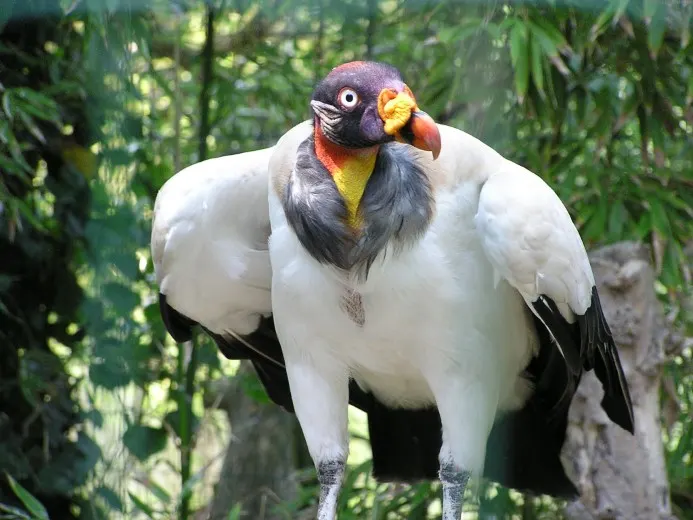
The King Vulture (Sarcoramphus papa) is a majestic scavenger bird of the tropical forests of the Americas, with striking black and white plumage and a colorful head. It is a key cleaner of the ecosystem, living from Mexico to Argentina. In Peru, it can be seen in reserves such as Manu and Bahuaja-Sonene. Its conservation is vital to maintain ecological balance and promote ecotourism. Contact us and book your trip to the Peruvian jungle where you’ll have the chance to see the majestic King Vulture.

